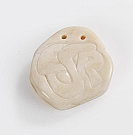
Heinz Hajek-Halke
1898 Berlin
1983 Berlin
Heinz Hajek-Halke was born in Berlin on December 1, 1898, but spent his childhood in Argentina. Back in Germany, he began to study graphics in Berlin in 1915. In 1916, he served as a soldier in World War I; thereafter he continued his studies.
Hajek-Halke began to take photographs in 1924, and soon he had work with the agency "Presse-Photo". He experimented with photographic techniques – among them light montages, double exposures, photo collages and photo montages. One special technique is "combi-photography," in which Hajek-Halke mounted several negatives for one print. His pictures were innovative and made use of the newly discovered possibilities for manipulating photographs.
According to Hajek-Halke himself, he wanted "to place [...] an illusionistic actuality next to natural reality with all of the means available through advanced photographic technology, maintaining artistic principles". He worked in advertising, created reportages and took nude photographs.
In 1933, Hajek-Halke opposed the order by the NSDAP to falsify documentary films and moved to Lake Constance, where he worked with macro photographs of insects. In 1937, he created several photo reportages in Brazil. Two years later, he worked as a photographer at the Dornier-Werken in Friedrichshafen. In the last year of the war, he found himself imprisoned in France, but was able to flee soon thereafter.
Hajek-Halke was fascinated with snakes and built his own viper farm; he kept working with experimental photography. He created flexible figures out of wire which served as subjects for his photographic experiments ("light graphics"). In 1949, he met Otto Steinert, who belonged to the group "fotoform". Hajek-Halke became a member of the group for a short while, and six years later he was appointed Professor of Photography and Photographics at the University of the Arts in Berlin.
His pictures were seen at the first exhibit "subjective photography".
Hajek-Halke died in Berlin on May 11, 1983. His work connected the photography of "Neues Sehen" [New Seeing] with the experiments of the group "fotoform" and of "subjective photography" in Germany of the post-war era.

Would you like to sell a work by Heinz Hajek-Halke?
Infos for sellerART MARKET:

Oil on canvas in four parts, wood, metal wire, 1966
Estimated price 1.000.000
More offers >






